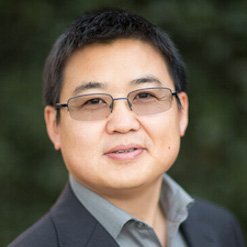The Michigan State University Research Foundation (MSU Research Foundation) and Michigan State University announced the recipients of the 2023 Strategic Partnership Grants Program (SPG Program), an important funding mechanism that supports promising new initiatives in key areas of research, scholarship, and multidisciplinary collaboration. Successful concepts aim to promote productive and sustained collaborations at MSU, leading to significant external funding and driving ideas with long-term impact. The SPG Program is jointly funded by the MSU Research Foundation and MSU colleges. After a rigorous internal peer review process conducted by MSU faculty and research administrators, the top five proposals were submitted to the foundation’s Grants Committee for presentation and review.
Three proposals were selected for funding:
-
Next Generation Diamond Reactor for Inch-Size Wafer Realization
-
AI Center for Drug Discovery
-
Novel Cancer Immunotherapy by Restoring Antigen Presentation
“The Strategic Partnership Grants Program is a vital component of our research efforts at Michigan State,” said Doug Gage, the university’s vice president for Research and Innovation. “Many of the projects have potential for commercial application but are still in their early stages. This funding has enabled MSU to support leading-edge research and scholarship and build on MSU’s status as one of the nation’s leading research institutions.”

Next Generation Diamond Reactor for Inch-Size Wafer Realization
The next generation diamond reactor project aims to unlock the extraordinary electronic, mechanical and thermal properties of single-crystal diamond (SCD) grown at a size of an inch or larger (known as a mesoscale). This could lead to advancements in fields including energy, defense, communications, manufacturing, transportation and space.
During the formation of high-quality SCD, as a sample grows larger, defects accumulate at the edges, leading to the formation of polycrystalline grains rather than continued growth of a single crystal. This means that the growth of high-quality SCD currently is limited to specimens that are too small to be useful in a modern electronics fabrication process.
Mechanical Engineering Associate Professor Rebecca Anthony, the lead principal investigator (PI) for the project, said that achieving defect-free mesoscale growth of SCD requires a multidisciplinary research investigation that leverages cutting-edge reactor metrology and the intermeshing of experimental and modeling work. The project will galvanize a team consisting of Anthony and three other researchers from the College of Engineering together with Fraunhofer USA CMW to build the foundational efforts for realizing mesoscale SCD growth.
“Once we move beyond its current growth limitation, high-quality, mesoscale SCD offers tremendous potential,” Anthony said. “This project will address the problem by combining four elements: a new hyper-spectral imaging capability to acquire much more detailed data about what is happening inside the plasma reactor during diamond growth; detailed modeling of the plasma during growth; detailed modeling of the chemical kinetics occurring during growth; and design, construction, and testing of new ‘pocket’ sample holders to test their efficacy in improving the quality of the grown diamonds.”

AI Center for Drug Discovery
A key goal of the AI Center for drug discovery (AID) is to develop a new drug discovery core that leverages artificial intelligence (AI).
In drug discovery, while numerous AI-based ventures have raised hundreds of millions of dollars in funding over the past few years, most companies face a shortage of talent equipped with data science and pharmacology backgrounds, and few research institutes have initiated a joint force to embrace the unprecedented opportunity AI affords. Academic institutes have unique advantages in creating a whole ecosystem to democratize AI in drug discovery.
“The AI center for drug discovery at MSU is expected to span multiple colleges and research labs, train the next generation of scientists with unique expertise, and ultimately evolve into a sustainable research and education program,” said Pediatrics and Human Development Associate Professor Bin Chen, the lead PI for the project.
AID will be governed by five scholars representing four departments across four colleges. It will integrate into the existing drug discovery program and has the potential to expand rapidly to other units and clinical partners.

Novel Cancer Immunotherapy by Restoring Antigen Presentation
The main goal of the novel cancer immunotherapy project is to develop a next-generation immunotherapy that can treat cancer patients who do not respond to the current immune checkpoint inhibitor therapy.
The lead PI for this project is Microbiology and Molecular Genetics Associate Professor Dohun Pyeon. He said more than 80 percent of patients do not respond to immune checkpoint inhibitors, and many of these patients develop cancers that are invisible to T cell surveillance.
“It has therefore become clear that there is an urgent need for innovative cancer immunotherapeutics that enhance antitumor T cells to detect and kill cancer cells,” Pyeon said. “We have identified a potential new immunotherapy target (MARCHF8), a key factor to allow cancer cells to be undetectable, with a unique mechanism for treating cancer.”
Pyeon is optimistic about the project’s success.
“Our project is an ideal high risk, yet high return proposition that may bring a huge opportunity to command a new category of cancer immunotherapy,” he said.
David Washburn, executive director of the MSU Research Foundation, praised the grant recipients.
“The three projects awarded funds represent the best in cutting-edge research at Michigan State that offers great promise for the future,” Washburn said. “This should yield great advancements and benefits for years to come.”
Since 2001, the Michigan State University Foundation has provided more than $37 million in funding for over 73 SPG projects that have been able to able to raise in excess of $100 million in outside funding from state and federal funding sources.
Examples include seed funding for the Center for Integrated Study of Vision and Language, Center for Statistical Training & Consulting, Center for Systems Biology, Center for Materials in Nanotechnology, Center for Structural Fire Engineering, Accelerator Technology Modeling Center, the Institute for Quantum Sciences and the Institute for Biodiversity, Ecology, Evolution, and Macrosystems.
This story was first published by the MSU Research Foundation.
Interested in collaborating with the MSU Research Foundation? Click Here
